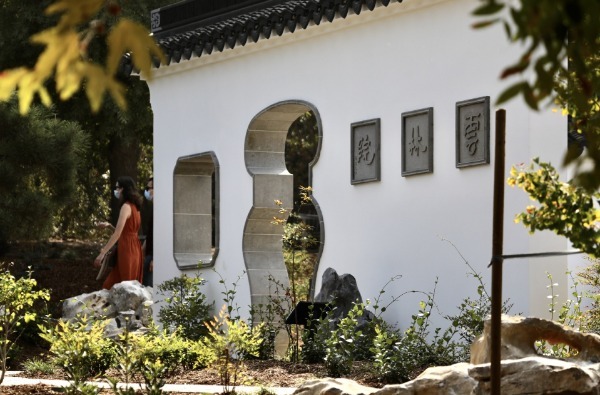

Postponed for over a year due to COVID-19, the Huntington Library, Art Museum and Botanical Gardens in Los Angeles County marked the completion of its Chinese garden on Saturday with the opening of an exhibition of contemporary Chinese calligraphy.
Nicole Cavender, director of the Botanical Gardens who joined the Huntington in May, was enthusiastic about the experience that the new exhibition, entitled "A Garden of Words, the Calligraphy of Liu Fang Yuan," had to offer its visitors.
The exhibition "really transports people to another world," she told Xinhua.
It represented a celebration of words and titles expressed in the elegant, time-honored art form of Chinese characters ink-brushed onto paper, known as calligraphy.
As an extremely important part of Chinese history and culture, calligraphy was no less important to the Huntington's formal Chinese garden, said experts from the famous culture research institute in the United States.
"Calligraphy is fundamental to a Chinese garden," said Phillip Bloom, curator of the Chinese Garden and director of the Center for East Asian Garden Studies. "But it is a feature that often goes overlooked by visitors, especially those who do not read Chinese."
But these elegantly written words are given pride of place in "Liu Fang Yuan," the Huntington's Chinese Garden of Flowing Fragrance. Wherever visitors turn, evocative titles like "Listening to the Pines" and "Jeweled Blossoms Slope" provide poetic names for the architectural features, lovely nooks, and expansive views that make up the exquisite space.
For the exhibition, the original scrolls commissioned by the Huntington as models for these inscriptions had been assembled and put on display in their recently completed art gallery "The Studio for Lodging the Mind."
With a chuckle, Bloom told Xinhua that the studio's rather whimsical name was derived from an 11th Century essay by a famous Chinese scholar, penned as a subtle warning that one must strive for balance by lodging one's mind only temporarily on a subject, never dwelling on it too long, lest it become an obsession.
The exhibition featured the work of 21 contemporary, male and female calligraphers who hail from all over the globe.
The Huntington said their selection of artists includes "professional calligraphers and avid amateurs, scholars and physicians, a Chinese painter living in New York and a New York photographer residing in China."
Each artist's work varies dramatically from any other and the art form offers ample scope for self-expression, despite the simplicity of their shared materials of brush, ink and paper.
Works often reflected the artist's own character and demonstrated the complex symbolism that lied at the heart of calligraphy, long considered a medium of "imaginative communion that links calligrapher and viewer, past and present," said the brochure of the exhibition.
The exhibition also likened calligraphy to dance, where the brush becomes "a dancer that rises and falls, twists and turns in space, leaving lines of ink on the paper ... like dance steps," as the calligraphers subtly vary each stroke according to their artistic sensibilities.
Michelle Bailey, assistant curator for the exhibition, said that the Huntington had dedicated the last 20 years to developing its Chinese garden, and "its purpose is to celebrate and teach the culture of China."
"The Huntington's 130 acres of botanical gardens are not only for display of our world-class collections of plants and behind the scenes botanical science, they also foster immersion in cultural and educational experiences and serve to connect botanical, art, and library collections with global themes," said Cavender. "The Chinese garden exemplifies this."